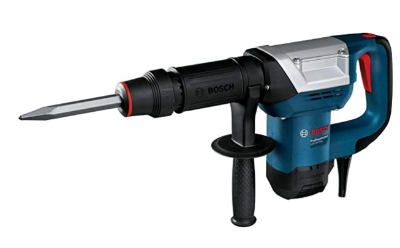What Is a Concrete Vibrator?
Concrete vibrators are construction equipment used to compact concrete that has not yet been set (ready-mixed concrete).
After the concrete is poured into a formwork, vibration improves the fluidity and increases the density of the concrete. This action removes air from the concrete and distributes the aggregate evenly.
In the past, there were no machines such as concrete vibrators, so the formwork was pounded with a mallet or other tool, or the concrete was repeatedly pierced with a bamboo stick. It is said that this is why the term “placing” came to be used to refer to placing ready-mixed concrete.
Concrete vibrators have evolved over the years, and lightweight and convenient products have been developed, such as cordless types that can work without a power cable, and types equipped with a system that automatically turns the power on and off.
Uses of Concrete Vibrators
Concrete vibrators are mainly used at construction sites and in the manufacturing process of concrete products.
Examples of concrete vibrators are as follows
- Placing concrete structures such as buildings and bridges
- Casting concrete for housing foundations, retaining walls, etc.
- Production of secondary concrete products such as gutters and retaining walls
- Compaction of concrete pavements
- Production of test pieces
Used in many locations to improve the strength and quality of concrete.
Principle of Concrete Vibrators
Typical concrete vibrators consist of a main body with an internal motor, a vibrating section at the end, a flexible shaft, and an electric rod. Vibrating parts of various shapes and sizes transmit vibrations to the cast concrete to ensure uniformity and density of the concrete material.
There are two main types of vibration mechanisms: the “internal vibration method,” which transmits vibration by inserting directly into the concrete, and the “formwork vibration method,” which transmits vibration indirectly from the outside. Concrete vibrators fall into the “internal vibration method” and are used on many job sites.
Concrete compaction, when done properly, results in good-quality concrete. Excessive vibration can cause “bleeding,” which is the separation of water from the material, and insufficient compaction can cause “jankers” that result in an uneven surface. Not only do these problems make the concrete look unsightly, but they also cause problems of insufficient strength, so care must be taken when installing concrete.
How to Select Concrete Vibrators
Concrete vibrators vary in terms of power source, the shape of the vibrating section, the diameter of the vibrating section, etc., depending on the product, so it is important to understand the features of each type and purchase the one that best suits the purpose of use.
1. Power Supply System
There are two types of power sources: AC and rechargeable. The AC power supply system is used at construction sites where a power supply is available and cable routing is not a problem. The rechargeable type should be used at construction sites where it is difficult to secure a power source.
The rechargeable type is available in 14.4 V, 18 V, and 36 V. The higher the voltage, the stronger the vibration, but the heavier it tends to be.
2. Shape of Vibrating Part
Concrete vibrators are classified into the following four types. Each type has a different shape of vibrating part, so it is important to select the appropriate type for your application.
Flexible Type
The hose part can be bent freely, so it can be used in places where the electric rod type cannot be used. This type is used for compaction of overcrowded reinforcement sites and narrow gaps in walls, beams, etc.
Electric Rod Type
The vibrating part of this vibrator is shaped like a rod, which is not soft but has a low vibration. This type is used for concrete processing in factories and at the tops of reinforcing bars.
Spatula Type
This type of vibrator has a spatula-shaped vibrating section and is used in the manufacture of thin concrete products such as U-shaped ditches and catch basins.
Punch Type
This type of concrete vibrator is used for removing air bubbles from inclined surfaces where air bubbles are difficult to escape, and for finishing the surface of concrete products in narrow formwork. It is also used in the manufacture of large products such as revetment blocks and rooting blocks.
3. Diameter of Vibrating Section
The diameter of the vibrating section of a concrete vibrator is a major factor in its operating efficiency. The effective range of vibration is considered to be about 10 times the diameter of the vibrating section, and the larger the diameter, the wider the effective range and the fewer times compaction is required. The larger the diameter, the wider the effective range and the fewer the number of compaction cycles. Using the right size product for the job will improve work efficiency and reduce working time.
Other Information on Concrete Vibrators
Precautions for Use
When using concrete vibrators, please note the following
- Vertically insert the vibrators at equal intervals.
- Vibration should be applied for 15 to 20 seconds. If more than 15 to 20 seconds is applied, material separation may occur.
- In the case of reinforced concrete construction, work so that the vibrator does not come into contact with the reinforcing steel bars inside the structure.
- Do not turn off the concrete vibrators while they are plugged in.
- Since this is a vibrating tool, take moderate breaks or use anti-vibration gloves.

 A Scale is a general term for a tool to measure the weight of a material.
A Scale is a general term for a tool to measure the weight of a material.